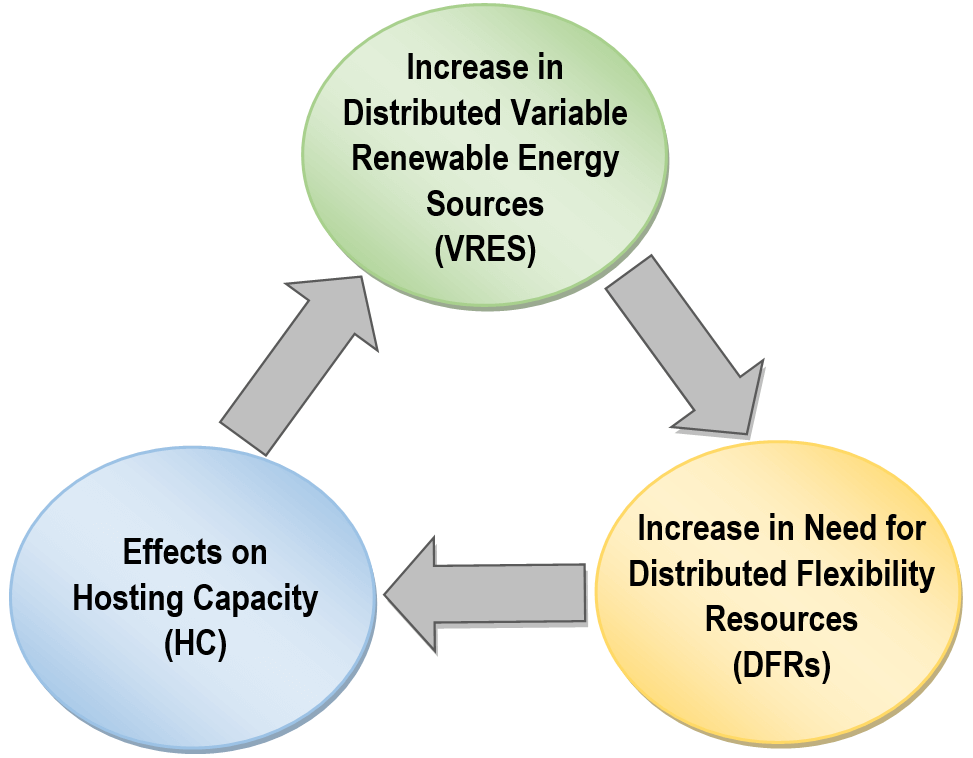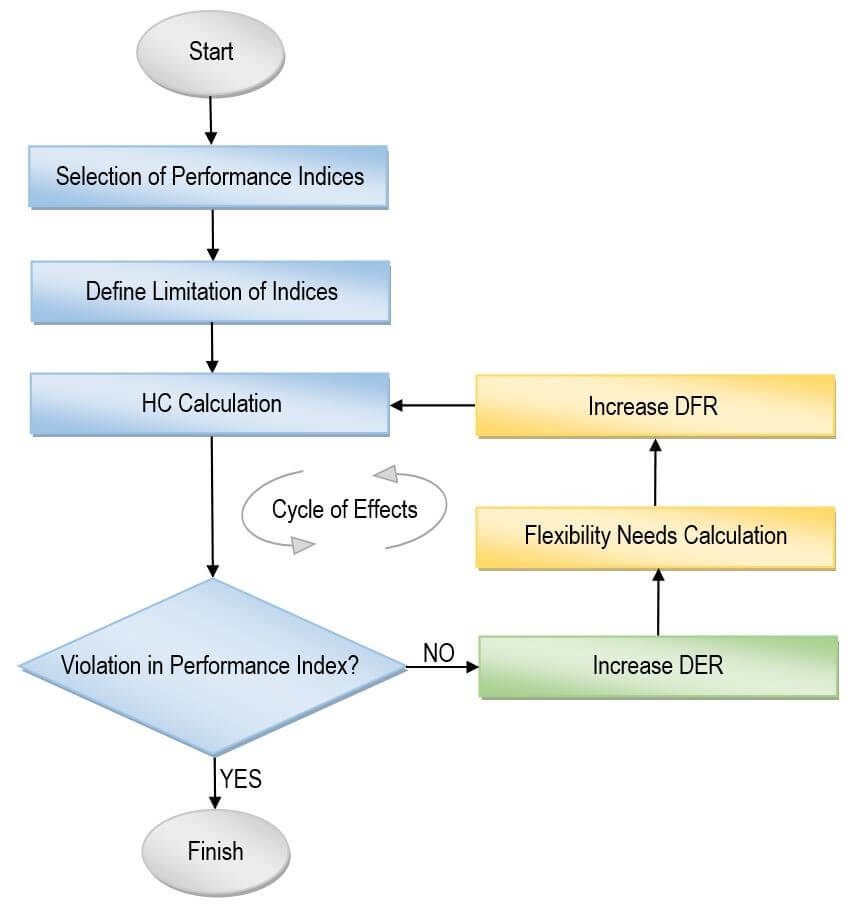Effects of Distributed Flexibility Resources on Hosting Capacity
Written by Milad Mousavi
Flexibility resources are an integral part of the solutions to the intermittency associated with the unprecedented increase in variable renewable energy sources (VRES). In this regard, not only can distributed flexibility resources (DFRs) provide grid and system services, but also can offer opportunities to improve the hosting capacity (HC) of the distribution systems. Therefore, it is essential to consider the effects of DFRs on novel techniques of HC studies and the challenges ahead. Some questions arise on the matter: How do DFRs affect the HC studies’ characteristics and assessment? Subsequently, how can the affected HC studies improve the integration of distributed VRES?
Motivation
According to the common definitions, HC studies ensure adequate system operation according to standards and grid codes at the maximum penetration of distributed energy resources (DERs) into a given distribution grid, without any modifications to the existing infrastructure [1]. Several works review fundamental concepts and basics [2], tools and methods [3], and more novel techniques [4]. There are various techniques proposed to increase the HC in a given system such as network reconfiguration (NR), soft open points (SOPs), on-load tap changer (OLTC), and smart inverter capabilities. DFRs such as energy storage systems (ESSs) and demand response programs (DRPs) can also contribute to these straightforward approaches.
Methodology
DFRs are mainly used to provide flexibility services for both transmission and distribution system operators. However, DFRs have an impact themselves on HC. As an example, consider the incorporation of photovoltaics (PV). Battery ESS can provide flexibility to cope with the uncertainty of solar radiation and thereafter, fluctuations in the PV’s output. Meanwhile, the new ESS may be considered for additional HC, and allow adding more DERs or distributed VRES. These circular effects among the HC planning/assessment stages are illustrated in Figure 1. The optimal point in this forward feedback (circular) process would yield the amount of necessary new DERs and DFRs and how HC is affected. To a certain extent, the output promises that the uncertainty of new distributed VRES can be handled by the optimal DFRs. Hence, studying such kinds of effects is of great importance for decision-making on investments and operations of DERs and DFRs. The advantage of this type of HC calculation in increasing DER is that it is “specific, measurable, and practical” [3]. With such sets of assets, increasing the HC of distribution systems in DERs is more effective and efficient.

Figure 1: Cycle of effects in incorporating DERs and DFRs.
Assessing Hosting Capacity with Performance Indices
Performance Indices are widely used to represent the properties of the distribution grid that limit the integration of DERs based on typical operating and component standards. For instance, increasing PV penetration at a bus may lead to a voltage increase beyond the grid voltage limit. In this case, overvoltage is a limiting factor to increasing PV penetration. To calculate HC with respect to performance indices, the major limiting factors which are necessary for HC studies are Voltage Deviation, Thermal Overload, Power Losses, Power Quality, and Protection Devices. HC assessment can be quantified as a customer-based or utility-based approach [5]. In the former method, the utility has no control over the size, location, and number of DERs. In the latter, the utility-based method can be defined as an optimization problem, wherein the objective of this problem is to maximize the penetration of DERs with respect to the performance indices. An approach that can effectively enhance DER penetrations, while respecting system operation should use an optimal power flow to calculate the value of voltages and currents, i.e. of the said indices. Figure 2 depicts a flowchart regarding the main steps of such a methodology. After defining the limits of the performance indices according to local grid code or component limits, the algorithm explores the forward feedback (circular) assessment discussed earlier. At each iteration, the violation of any performance indices is checked. It is noteworthy to mention that, typically, incorporating DERs does not necessarily require flexibility since the performance indices will determine the proper energy mix. With the proposed forward feedback method, the value of flexibility assets to cope with the intermittent generation of distributed VRES is more clearly considered. These DFRs are, essentially, the basis of the presented cycle of effects on the HC.

Figure 2: Flowchart of the methodology.
Summary
As the energy transition necessitates incorporating renewable energy-based generation, DFRs can be an asset to cope with the inevitable uncertainty and may be reflected in novel HC study frameworks. HC definitions and applications must be rethought and a new broader framework to evaluate the effects of new DFRs on HC studies on distribution systems could be considered. Thus, HC calculation methods can extend beyond the performance indices and see the problem from new angles.
References
- IBollen M, Häger M. Power quality: interactions between distributed energy resources, the grid, and other customers. Leonardo Energy. 2005.
- Ismael SM, Aleem SH, Abdelaziz AY, Zobaa AF. State-of-the-art of hosting capacity in modern power systems with distributed generation. Renewable Energy. 2019 Jan 1;130:1002-20.
- Zain ul Abideen M, Ellabban O, Al-Fagih L. A review of the tools and methods for distribution networks’ hosting capacity calculation. Energies. 2020 Jan;13(11):2758.
- Moro VC, Trindade FC. A Review on Techniques to Increase Hosting Capacity of Distribution Systems to DERs. In2021 Workshop on Communication Networks and Power Systems (WCNPS) 2021 Nov 18 (pp. 1-6). IEEE.
- Sadeghian H, Wang Z. A novel impact-assessment framework for distributed PV installations in low-voltage secondary networks. Renewable Energy. 2020 Mar 1;147:2179-94.
This article was edited by Panos Moutis.
To view all articles in this issue, please go to August 2022 eBulletin. For a downloadable copy, please visit the IEEE Smart Grid Resource Center.

Milad Mousavi is a Ph.D. student in Electric Power Engineering at the Luleå University of Technology, Skellefteå, Sweden. He is working on flexibility resources and their economic incentives for investors in electricity and energy markets. His research investigates the impacts of distributed flexibility resources on flexibility pricing, hosting capacity, and integration of distributed variable renewable resources.
To have the Bulletin delivered monthly to your inbox, join the IEEE Smart Grid Community.
Past Issues
To view archived articles, and issues, which deliver rich insight into the forces shaping the future of the smart grid. Older Bulletins (formerly eNewsletter) can be found here. To download full issues, visit the publications section of the IEEE Smart Grid Resource Center.




